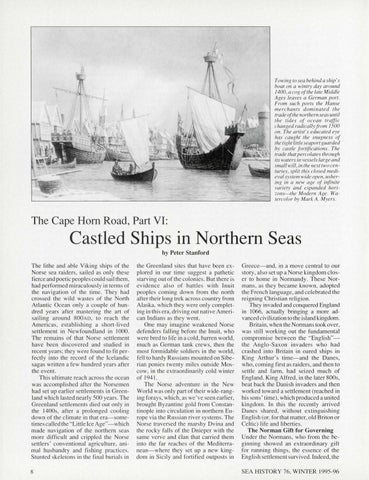Towing to sea behind a ship's boat on a wintry day around 1400, a cog of the late Middle Ages leaves a German port. From such ports the Hans e merchants dominated th e trade ofthe northern seas until the tides of ocean traffic changed radical/y.fi¡om 1500 on. The artist's educated eye has caught th e snugness of the tight little seaport guarded by castle fortifications. The trade that percolates through its waters in vessels large and small will, in the next two centuries, split this closed medieval system wide open, ushering in a new age of infinite variety and expanded horizons--the Modern Age. Watercolor by Mark A. Myers.
The Cape Hom Road, Part VI:
Castled Ships in Northern Seas by Peter Stanford The lithe and able Viking ships of the Norse sea raiders, sailed as only these fierce and poetic peoples could sail them, had performed miraculously in terms of the navigation of the time. They had crossed the wild wastes of the North Atlantic Ocean only a couple of hundred years after mastering the art of sailing around 800AD, to reach the Americas , establishing a short-lived settlement in Newfoundland in 1000. The remains of that Norse settlement have been discovered and studied in recent years; they were found to fit perfectly into the record of the Icelandic sagas written a few hundred years after the event. This ultimate reach across the ocean was accomplished after the Norsemen had set up earlier settlements in Greenland which lasted nearly 500 years. The Greenland settlements died out only in the 1400s, after a prolonged cooling down of the climate in that era-sometimes called the "Little Ice Age"-which made navigation of the northern seas more difficult and crippled the Norse settlers' conventional agriculture, animal husbandry and fishing practices. Stunted skeletons in the final burial s in
8
the Greenland sites that have been explored in our time suggest a pathetic starving out of the colonies. But there is evidence also of battles with Inuit peoples coming down from the north after their long trek across country from Alaska, which they were only completing in this era, driving out native American Indians as they went. One may imagine weakened Norse defenders falling before the Inuit, who were bred to life in a cold, barren world, much as German tank crews, then the most formidable so ldiers in the world, fell to hardy Russians mounted on Siberian ponies twenty miles outside Moscow, in the extraordinarily cold winter of 1941. The Norse adventure in the New World was only part of their wide-ranging forays, which, as we've seen earlier, brought Byzantine gold from Constantinople into circulation in northern Europe via the Russian river systems. The Norse traversed the marshy Dvina and the rocky falls of the Dnieper with the same verve and elan that carried them into the far reaches of the Mediterranean-where they set up a new kingdom in Sicily and fortified outposts in
Greece-and, in a move central to our story, also set up a Norse kingdom closer to home in Normandy. These Normans, as they became known , adopted the French language, and celebrated the reigning Christian religion . They invaded and conquered England in I 066, actually bringing a more advanced civilization to the island kingdom. Britain, when the Normans took over, was still working out the fundamental compromise between the "English"the Anglo-Saxon invaders who had crashed into Britain in oared ships in King Arthur's time-and the Danes, who, coming first as raiders, and then to settle and farm, had seized much of England. King Alfred, in the later 800s, beat back the Danish invaders and then worked toward a settlement (reached in his sons' time) , which produced a united kingdom. In this the recently arrived Danes shared, without extinguishing English (or, for that matter, old Briton or Celtic) life and liberties.
The Norman Gift for Governing Under the Normans, who from the beginning showed an extraordinary gift for running things , the essence of the English settlement survived. Indeed, the SEA HISTORY 76, WINTER 1995-96
